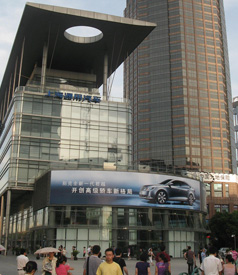Seven thousand miles from Detroit, GM builds a great wall of Buicks.
Boston – Can things get any worse for Detroit?
First, a suspected Islamic terrorist tries to blow up an airplane over the city (with a bomb in his underwear, no less).
Then this week General Motors — the company that helped put the motor in Motor City — said sales in China surged 67 percent in 2009, even as the U.S. auto industy collapsed, further decimating Detroit’s economy.
GM sold more than 1.8 million cars and trucks in China, just below what it sells in the U.S.
To rub Sichuan hot bean paste into the city’s wounds, those China sales were led by Buick — a stodgy brand that, for years in the U.S. market, GM has been trying to rid of the old man smell. Even a pre-scandal Tiger Woods couldn’t turn that trick: GM and Woods parted ways in 2008 after a nine-year marketing partnership that featured the young, hip and (then) wholesome golfer.
But Buick isn’t the company’s only happiness in China lately.
GM and its joint venture partners also saw big sales jumps in cheaper “microvans” (think really small minivans) and pick-ups, which play well in China’s vast rural areas. GM now owns a 13.4 percent market share in China, the world’s fastest-growing market for automobiles — not bad for a bankrupt company that took $50 billion in U.S. bailout money last year.
GM’s success in the dragon is the result of several factors.
The first, of course, is China’s rapid growth, which has created a large and growing army of consumers ready to get behind the wheel. Fueled by big government incentives, China’s overall auto market grew a staggering 50 percent last year, for the first time dethroning the U.S. as the largest vehicle market in the world.
U.S. consumers bought 10.5 million cars and trucks in 2009. The Chinese bought 13 million. While that number is expected to drop significantly this year as Beijing’s incentive programs wind down, China is now critically important for automakers worldwide.
“There’s no question that China will become the world’s largest auto market as long as the economy keeps growing,” Kelly Sims Gallagher, a professor at Tufts University, told the Washington Post this week.
Here’s why: In the U.S. there are 850 cars for every 1,000 people. In China, there are currently 35 cars per 1,000 people. That’s a lot of room for growth.
Now factor in China’s population of 1.3 billion people and its rapidly growing middle class, and you can see what GM, Ford, Volkswagen, Hyundai, Changan, Shanghai Automotive Industry and other global and local automakers are fighting over.
But economic growth doesn’t entirely explain GM’s success in China. The missing piece? Smart marketing, particularly of Buick — something the company isn’t exactly famous for in Detroit.
In China, General Motors has done a superb job of pitching Buick as a cool, even sexy, luxury car. It’s not viewed as something your grandfather would drive. Instead, GM positioned Buick as an aspirational brand that fits in perfectly with China’s national go-go race to modernity.
As a result, the Buick has become a symbol of the country’s rising prosperity — a fun, four-wheeled, tactile embodiment of Deng Xiaoping’s famous phrase, “To get rich is glorious.”
GM recognized that important trait in China’s newly prosperous consumers. It then gave the brand just the right marketing push, as evidenced by this 2009 TV spot for its Buick Regal Turbo that features a pair of prosperous Shanghai hipsters:
Of course, plenty could still go wrong for GM in the dragon.
Local or other global automakers could produce better vehicles, driving GM out of the market. Its domestic and other global problems could sink the overall company. China Inc. could crash, as was predicted this week by James S. Chanos — a hedge fund investor who made his fortune by foreseeing bad things (like Enron’s collapse) where almost everyone else sees promise.
Then, of course, there is the question of how to cope with the environmental impact of millions upon millions of new cars hitting Chinese roads every year, belching CO2 into the planet’s atmosphere.
But until then, GM will try to capitalize on its early gains in China. It’s expected to add 10 new products in the country this year, including a redesigned minivan. GM will also update its existing model line-up, including sleeker versions its HRV compact car, and yes, its popular Buick Excelle.
What’s Mandarin for, “Sorry, Detroit?”
Press freedom is under attack
As Trump cracks down on political speech, independent media is increasingly necessary.
Truthout produces reporting you won’t see in the mainstream: journalism from the frontlines of global conflict, interviews with grassroots movement leaders, high-quality legal analysis and more.
Our work is possible thanks to reader support. Help Truthout catalyze change and social justice — make a tax-deductible monthly or one-time donation today.
